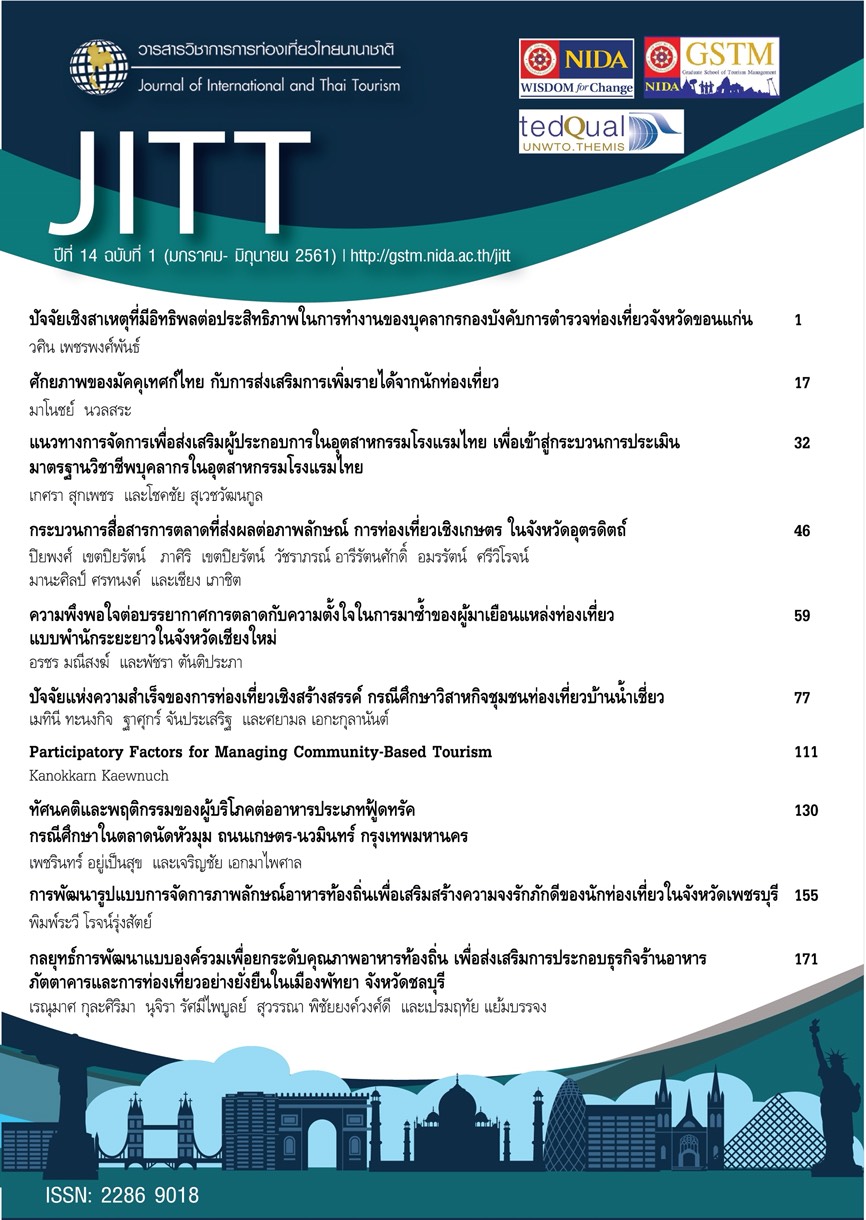ทัศนคติและพฤติกรรมของผู้บริโภคต่ออาหารประเภทฟู้ดทรัค กรณีศึกษา ในตลาดนัดหัวมุม ถนนเกษตร-นวมินทร์ กรุงเทพมหานคร
Main Article Content
บทคัดย่อ
การศึกษานี้มีวัตถุประสงค์เพื่อศึกษาองค์ประกอบของทัศนคติ พฤติกรรม และแนวโน้มการกลับมาใช้บริการของผู้บริโภคอาหารฟู้ดทรัค ด้วยวิธีสัมภาษณ์เชิงลึก โดยผู้ให้ข้อมูลหลักเป็นผู้บริโภคในพื้นที่ตลาดนัดหัวมุม ถนนเกษตร-นวมินทร์ที่เคยรับประทานอาหารฟู้ดทรัค จำนวน 25 คน ผลการศึกษาพบว่า 1) องค์ประกอบของทัศนคติของผู้บริโภคอาหารฟู้ดทรัคนั้น ผู้บริโภคส่วนใหญ่เข้าใจแนวคิดของฟู้ดทรัค ขณะที่บางคนอาจจะยังไม่คุ้นเคยกับแนวคิดและคำศัพท์ 2) ผู้บริโภคส่วนใหญ่มารับประทานอาหารฟู้ดทรัคแถวตลาดนัดกลางคืน โดยช่วงเวลาเย็นเป็นช่วงเวลาที่ผู้บริโภคส่วนมากไปกับเพื่อน ส่วนการตัดสินใจเลือกซื้อขึ้นอยู่กับข้อมูลที่ได้มาจากสังคมออนไลน์ 3) สำหรับแนวโน้มพฤติกรรมการกลับมาใช้บริการนั้น หลังจากที่ได้ไปบริโภค ผู้บริโภคจะแนะนำบอกต่อกับคนใกล้ชิด การศึกษาครั้งนี้แนะนำให้รัฐบาลควรจะสนับสนุนธุรกิจฟู้ดทรัคและให้มีการกระจายธุรกิจทั่วประเทศ รวมทั้งส่งเสริมให้ผู้ประกอบการนำวัตถุดิบและอาหารท้องถิ่นมาจัดจำหน่ายเป็นการสนับสนุนเอกลักษณ์ของคนท้องถิ่น และปรับรูปแบบอาหารให้มีความผสมผสานระหว่างอาหารตะวันตกและอาหารไทย
Article Details
เอกสารอ้างอิง
https://www.dbd.go.th/download/data_srevice/2sep.doc
กลุ่มฟู้ดทรัค (Food Truck) ขานรับเตรียมพร้อมสู่มืออาชีพ ด้วยมาตรฐานสากล. ข่าวสด. (2561). สืบค้นเมื่อ
19 สิงหาคม 2561, จาก https://www.khaosod.co.th/uncategorized/news_1288844
ฉัตยาพร เสมอใจ และมัทนียา สมมิ. (2545). พฤติกรรมผู้บริโภค. กรุงเทพฯ: เอ็กซเปอร์เน็ท.
ปรียาภรณ์ เวชประเสริฐ และธีระวัฒน์ จันทึก. (2559). ปัจจัยที่มีผลต่อพฤติกรรมการตัดสินใจ
เลือกบริโภคผลิตภัณฑ์นมและขนมปังของธุรกิจฟู้ดทรัตในเขตกรุงเทพมหานคร. ใน วิทยาลัยเทคโนโลยี
พนมวันท์, การวิจัยเพื่อการพัฒนา เผยแพร่ และถ่ายทอดเทคโนโลยีที่ทันสมัยต่อสังคมการประชุมวิชาการ
เสนอผลงานวิจัยระดับชาติ ครั้งที่ 1 (น. 401-404). นครราชสีมา: โรงแรมสีมาธานี.
พงศกร บุญพรัต และอภิวรรตน์ กรมเมือง. (2560). การตัดสินใจใช้บริการร้านอาหารประเภท
ฟู้ดทรัคของผู้บริโภคในเขตกรุงเทพมหานคร. ใน มหาวิทยาลัยราชภัฏสวนสุนันทา, การวิจัยเพื่อการ
พัฒนาอย่างยั่งยืน: การประชุมสวนสุนันทาวิชาการระดับชาติ ครั้งที่ 5. (น. 1055-1064). กรุงเทพฯ:
โรงแรมเดอะรอยัล ริเวอร์.
พลพัต สาเลยยกานนท์. (2560). รัฐหนุน “ฟู้ดทรัค” ดันตลาดรถบรรทุกเล็กโต. โพสต์ทูเดย์. สืบค้นเมื่อ 19
พฤษภาคม 2561,จาก https://www.posttoday.com/auto/473686
มหาวิทยาลัยมหิดล, วิทยาลัยการจัดการ. (2558). Food Truck Marketing – เพิ่มความแรง ให้ธุรกิจ
อาหารติดล้อ. การสัมมนาการตลาดเชิงอภิปราย. 1 กันยายน 2558.
รังสรรค์ ประเสริฐศรี. (2548). พฤติกรรมองค์กร. กรุงเทพฯ: ธรรมสาร.
วรรณกมล ถ้ำสุวรรณ. (2552). ทัศนคติและพฤติกรรมการใช้บริการร้านไก่กระต๊ากย่านเสนา
นิเวศน์ของผู้บริโภค. (สารนิพนธ์ปริญญามหาบัณฑิต). มหาวิทยาลัยศรีนครินทรวิโรฒ.
ศิริจรรยา เครือวิริยะพันธ์. (2559). Food Truck ในประเทศไทย: กระแสแฟชั่นหรือแนวโน้มใหม่.
วารสารเกษตรพระจอมเกล้า, 34(มกราคม – เมษายน), 109-117.
ศูนย์วิจัยกสิกรไทย. (2561). คาดมูลค่าตลาดร้านอาหารปี’ 61 ขยายตัวร้อยละ 4-5 (กระแสทรรศน์ ฉบับที่
2904). บทวิเคราะห์แนวโน้มธุรกิจ. สืบค้นเมื่อ 19 สิงหาคม 2561, จาก
https://www.kasikornresearch.com/th/analysis/k-econ/business/Pages/36839.aspx
สำนักข่าวอิศรา. (2556). Food truck พื้นที่อาหาร วิถีการกินแบบใหม่สังคมเมืองอเมริกัน. สืบค้นเมื่อ 10
ธันวาคม 2559, จาก https://www.isranews.org/thaireform/thaireform-documentary/18711-
Food-Truck.html
สุดารัตน์ เกิดสว่าง. (6 พฤษภาคม 2559). Food Truck ภัตตาคารติดล้อ
[กบนอกกะลา]. กรุงเทพฯ: โมเดิร์นไนน์ทีวี (ช่อง 9 MCOT HD).
อัญชนา พวงน้อย และพิทักษ์ ศิริวงศ์. (2559). รูปแบบและกลยุทธ์การดำเนินธุรกิจร้านอาหาร
เคลื่อนที่ (Food Truck) กรณีศึกษาร้านเมนูไข่ จังหวัดเพชรบุรี. ใน วิทยาลัยเทคโนโลยีพนมวันท์, การ
วิจัยเพื่อการพัฒนา เผยแพร่ และถ่ายทอดเทคโนโลยีที่ทันสมัยต่อสังคม: การประชุมวิชาการเสนอ
ผลงานวิจัยระดับชาติ ครั้งที่ 1 (น. 907-916). นครราชสีมา: โรงแรมสีมาธานี.
เอสเอ็มอีลีดเดอร์. (2558). ตลาดนัดหัวมุม เกษตร-นวมินทร์ แหล่งช้อปยามค่ำคืน. สืบค้นเมื่อ 10 ธันวาคม
2559, จาก https://www.smeleader.com/ตลาดนัดหัวมุม
Ajzen, I. (1991). The theory of planned behavior. Organizational Behavior and Human
Decision Processes, 50(2), 179–211.
B. Joseph Pine II, & Gilmore, J. H. (1998). Welcome to the Experience Economy. Harvard
Business Review. Retrieved August 18, 2018, from https://hbr.org/1998/07/welcome-to-
the-experience-economy
Barroco, C., Augusto, L., & Alto-paiva, L. E. (2016). Turismo Gastronómico Em Portugal :
Formas De Comunicar Os Produtos Endógenos Da Região Dão Lafões E Alto-Paiva. Revista
Anais Brasileiro de Estudos Turísticos ABET, 6(2), 23–39.
Bornstein, M. H., Jager, J., & Putnick, D. L. (2013). Sampling in Developmental Science:
Situations, Shortcomings, Solutions, and Standards. Developmental Review : DR, 33(4),
357–370.
Brehm, S. S., Kassin, S., & Fein, S. (1998). Social Psychology: Study Guide (4th ed.). Boston:
Houghton Mifflin College Div.
Cohen, D. A., Colaiaco, B., Martinez-Wenzl, M., Montes, M., Han, B., & Berry, S. H. (2017). Can
Latino food trucks (loncheras) serve healthy meals? A feasibility study. Public Health
Nutrition, 20(7), 1279–1285.
Doob, L. W. (1947). The behavior of attitudes. Psychological Review, 54(3), 135–156.
Edsor, B. (2017, July 27). The best street food to eat in 25 countries around the world.
Business Insider. Retrieved August 18, 2018, from https://uk.businessinsider.com/the-best-
street-food-to-eat-around-the-world-2017-7/#india-paratha-is-a-traditional-indian-flatbread-
and-can-be-served-on-its-own-as-a-snack-on-the-go-or-alongside-a-meal-as-pictured-here-
at-the-chandni-chowk-market-in-new-delhi-11
Ehrenfeucht, R. (2017). Do food trucks and pedestrians conflict on urban streets? Journal of
Urban Design, 22(2), 273–290.
Ferguson, L. (2018, April 19). Food Trucks as a Force for Social Justice. Tufts Now. Retrieved
August 18, 2018 from https://now.tufts.edu/articles/food-trucks-force-social-justice
Fishbein, M., & Ajzen, I. (1975). Belief, attitude, intention, and behavior: an introduction to
theory and research. Massachusetts: Addison-Wesley Pub. Co.
Frost, W., Laing, J., Best, G., Williams, K., Strickland, P., & Lade, C. (2016). Gastronomy,
Tourism and the Media. (Channel View Publications, Ed.). Bristol.
Gibson, J. L., Ivancevich, J. M., & Konopaske, R. (2011). Organizations: Behavior, Structure,
Processes (14th ed.). New York: McGraw-Hill.
Gold, J. (2012). How America Became a Food Truck Nation. Smithsonian Magazine. Retrieved
August 18, 2018, from https://www.smithsonianmag.com/travel/how-america-became-a-
food-truck-nation-99979799/
Hagaman, A. K., & Wutich, A. (2017). How Many Interviews Are Enough to Identify Metathemes
in Multisited and Cross-cultural Research? Another Perspective on Guest, Bunce, and
Johnson’s (2006) Landmark Study. Field Methods, 29(1), 23–41.
Hawkins, D., & Mothersbaugh, D. (2012). Consumer Behavior: Building Marketing Strategy
(12th ed.). Boston: McGraw-Hill Education.
Horng, J. S., & (Simon) Tsai, C. T. (2010). Government websites for promoting East Asian
culinary tourism: A cross-national analysis. Tourism Management, 31(1), 74–85.
Jamshed, S. (2014). Qualitative research method-interviewing and observation. Journal of
Basic and Clinical Pharmacy, 5(4), 87.
Jehn, K. A., & Jonsen, K. (2009). Using triangulation to validate themes in qualitative studies.
Qualitative Research in Organizations and Management: An International Journal, 4
(2), 123–150.
Kassin, S., Fein, S., & Markus, H. R. (2013). Social Psychology (9th ed.). Belmont: Cengage
Learning.
Krech, D., Crutchfield, R. S., & Ballachey, E. L. (1962). Individual in Society: a textbook of
social psychology. New York: McGraw-Hill.
Leung, L. (2015). Validity, reliability, and generalizability in qualitative research. Journal of
Family Medicine and Primary Care, 4(3), 324–327.
Malterud, K., Siersma, V. D., & Guassora, A. D. (2016). Sample Size in Qualitative Interview
Studies: Guided by Information Power. Qualitative Health Research, 26(13), 1753–1760.
Schiffman, L., & Kanuk, L. (2007). Consumer Behavior (9th ed.). New Jersey: Pearson.
Shea, G. (2018, August 8). Best 23 cities for street food from Miami to Tokyo. Retrieved
August 17, 2018, from https://edition.cnn.com/travel/article/best-cities-street-
food/index.html
Terhorst, P., & Erkuş-Öztürk, H. (2015). Urban tourism and spatial segmentation in the field of restaurants: the case of Amsterdam. International Journal of Culture, Tourism and Hospitality Research, 9(2), 85–102.
Tolkach, D., Chon, K. K. S., & Xiao, H. (2016). Asia pacific tourism trends: Is the future ours to see? Asia Pacific Journal of Tourism Research, 21(10), 1071–1084.
Torres Chavarria, L. C., & Phakdee-auksorn, P. (2017). Understanding international tourists’ attitudes towards street food in Phuket, Thailand. Tourism Management Perspectives, 21, 66–73.
White, J. (2017, November 30). Why Food Truck Businesses Are Revving Up. Inc. Retrieved August 18, 2018, from https://www.inc.com/hrci/inclusive-talent-management-an-overview.html
Whyte, W. H. (1988). City: Rediscovering the Center. New York: Doubleday.
World Bank Group. (2018). Thailand economic monitor: Beyond the innovation paradox April 2018. World Bank. Retrieved August 18, 2018, from https://pubdocs.worldbank.org/en/147711523275364465/TEM-Innovation-9-April-2018WEB3.pdf
Yin, R. K. (2009). Case Study Research: Design and Methods (4th ed.). California: Sage Publications.
Zimbardo, P. (1970). Influencing Attitudes and Changing Behavior; a Basic Introduction to Relevant Methodology, Theory, and Applications. Massachusetts: Addison-Wesley Publishing Company.


